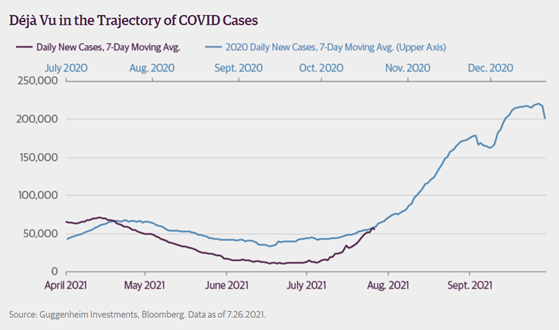Published on: 08/06/2021 • 6 min read
Avidian Report – Covid Update: What Investors Should Be Thinking About Now

INSIDE THIS EDITION:
This week’s market update focuses on COVID-19 and our thoughts on what the data is telling us and, more importantly, what investors should be thinking about as we move through the rest of the year.
COVID-19 Data Review
We have seen more and more headlines about COVID-19 as of late. When we survey the most recent data, we see that confirmed cases over seven-day rolling periods have been on the increase. This is driven mainly by the Delta variant of the virus and its increasing prevalence across the globe.

The chart above shows the moving average since the beginning of July quickly steepening. The initial wave of COVID-19 followed a similar trajectory. While the increase over the last seven days has been steeper than the initial wave, investors should be watching whether the magnitude of infections tracks closely with the first wave of confirmed cases in early 2020.
As of now, it appears that the Delta variant is considerably more transmissible than both the original strain and the Alpha variant. This explains why it has quickly become the more dominant strain. The chart below shows just how contagious each strain has been.

Similarly, we see country by country data that supports the notion that Delta’s prevalence is quite strong, especially in places like the United Kingdom, Singapore, and Denmark, where nearly all cases as of July 24 were attributed to the Delta variant.

Even though we have seen increasing numbers get vaccinated across geographies, vaccinated individuals still have the potential to contract and spread the virus.
The following table shows country by country trends in the new confirmed COVID-19 cases per million people.

Looking at data from the UK, for example, the number of confirmed cases declined between April 15 and May 27. However, as the more transmissible Delta variant became the dominant strain, the number of confirmed cases per million in the UK began trending higher. In contrast, we observe India showing the height of infections between April 1 and June 17 before producing solid improvements since then. These numbers in the context of mortality rates are shown in the chart that follows.

Again, focusing on both the UK and India, we see an encouraging sign – although the confirmed cases have spiked in places like the UK, the number of deaths per million people is improving. Similarly, we see a relatively small number of hospitalizations in the UK compared to the number of daily infections at present. This is a departure from what we saw during the wave they experienced in late 2020.

We can attribute the better outcomes to two things – first, a higher vaccination rate that appears to help reduce more severe cases, and second, more vigilance over symptoms.

In the US, the data seems to indicate that the vaccines have been effective at keeping new cases from spiraling out of control. However, as investors, we must continue to watch for signs that breakthrough infections in vaccinated individuals do not lead to lockdowns. While this is not our expectation, we encourage investors to be aware of that risk.
At this stage, the positive developments mixed with negative ones have made the path forward somewhat more uncertain. The biggest positive for the moment appears to be that vaccines appear to be highly effective at preventing severe infection. Further, with 50% or more of the US population now vaccinated, we think we are getting closer to some form of herd immunity, especially as more than 75% of Americans have some level of protection either from a previous COVID-19 infection or from a vaccination. However, we believe investors must balance this view by recognizing that breakthrough infections do occur and that the potential for new variants exists.
From an investment perspective, we think that although we face some risk from new variants, the government is likely to continue emphasizing social distancing and resist moving into a hard lockdown. Consumers may reduce spending on the service sector as they read headlines about new variants, but our view is that society will adapt to living with this virus, especially as it is looking more likely that it sticks with us for a long time, just like the flu has. However, if the current wave does worsen, investors might expect more fiscal policy support, a delay on Federal Reserve tapering, and potentially more government programs to help navigate short-term headwinds. This should provide a buffer against sharp market declines as liquidity continues to be a significant force. While the prospect for small corrective stock price movements is possible, we don’t see any long-term bear market on the horizon. This is particularly true when we consider the effectiveness of the vaccines, negative real yield on bonds, and the large amounts of liquidity sitting on the sideline ready to be allocated to risk assets.
Weekly Global Asset Class Performance

Please read important disclosures here
Get Avidian's free market report in your inbox

Schedule a conversation
Curious about where you stand today? Schedule a meeting with our team and put your portfolio to the test.*